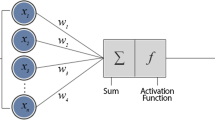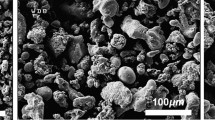Abstract
Epoxy resins are brittle because of their tight three-dimensional molecular network structures. In an attempt to overcome this issue, epoxies incorporating a combination of nanoclay (used for nano-reinforcement) and high-impact polystyrene (HIPS, used as the thermoplastic phase) were synthesized and tested in this work. The tensile, flexural, compressive, and impact strengths of these materials were evaluated. Various factors can influence these properties of hybrid nanocomposites during the preparation of such materials, so an artificial neural network (ANN) was employed to determine the effects of the clay, HIPS, and hardener loadings on the mechanical properties of the epoxy/HIPS/nanoclay nanocomposites and to develop models for predicting their mechanical behavior. A genetic algorithm (GA), a powerful optimization method, was employed to determine a fitness function that could calculate the optimum values of these mechanical properties. The results obtained indicated that the new ternary nanocomposites possess tensile, compressive, and impact strengths were improved up to 60 %, 64 %, and 402 %, respectively higher than those of the neat resin, although they did not show enhanced flexural strength. The tensile, flexural, and copmressive elongations at break were improved up to 53%, 38%, and 27% greater than those of neat epoxy, respectively. In addition, the fracture surface morphologies of the ternary nanocomposites were investigated by energy-dispersive X-ray spectroscopy (EDX) and scanning electron microscopy (SEM). The mechanical properties of the new ternary nanocomposites showed that they possess enhanced toughness compared to neat epoxy resin.










Similar content being viewed by others
References
LeBaron PC, Wang Z, Pinnavaia TJ (1999) Appl Clay Sci 15:11–29
Becker O, Varley RJ, Simon GP (2004) Eur Polym J 40:187–195
Becker O, Varley R, Simon G (2002) Polym 43:4365–4373
Liu W, Hoa SV, Pugh M (2005) Compos Sci Technol 65:307–316
Yasmin A, Luo J-J, Daniel IM (2006) Compos Sci Technol 66:1182–1189
Mirmohseni A, Zavareh S (2010) Mater Des 31:2699–2706
Mirmohseni A, Zavareh S (2011) J Polym Res 18:509–517
Mohan TP, Kumar MR, Velmurugan R (2006) J Mater Sci 41:2929–2937
Alsewailem FD, Gupta RK (2006) Can J Chem Eng 84:693–703
Garg AC, Mai Y-W (1988) Compos Sci Technol 31:179–223
Kinloch AJ, Shaw SJ, Tod DA et al (1983) Polym 24:1341–1354
Brooker RD, Kinloch AJ, Taylor AC (2010) J Adhes 86:726–741
Sultan JN, McGarry FJ (1973) Polym Eng Sci 13:29–34
Pearson RA, Yee AF (1991) J Mater Sci 26:3828–3844
Frounchi M, Mehrabzadeh M, Parvary M (2000) Polym Int 49:163–169
Chen TK, Jan YH (1992) J Mater Sci 27:111–121
Ramakrishna HV, Priya SP, Rai SK (2007) J Appl Polym Sci 104:171–177
Torres A, López-de-Ullibarri I, Abad MJ et al (2004) J Appl Polym Sci 92:461–467
Yun NG, Won YG, Kim SC (2004) Polym Bull 52:365–372
Kimoto M, Mizutani K (1997) J Mater Sci 32:2479–2483
Mimura K, Ito H, Fujioka H (2000) Polym 41:4451–4459
Rose LRF (1987) Mech Mater 6:11–15
Faber KT, Evans AG (1983) Acta Metall 31:577–584
Zaryabi A, Ben Hamza A (2012) Neural Comput Appl 21:1–9
Lim Y, Kang S (2012) Neural Comput Appl 21:1931–1936
Masri SF, Chassiakos AG, Caughey TK (1993) J Appl Mech 60:123–133
Ghaboussi J, Garrett J Jr, Wu X (1991) J Eng Mech 117:132–153
Rhim J, Lee SW (1995) Comput Mech 16:437–443
Su C-T, Wang F-F (2012) Neural Comput Appl 21:2127–2135
Song RG, Zhang QZ (2001) Mater Sci Eng C 17:133–137
Chung JS, Hwang SM (1997) J Mater Process Technol 72:69–77
Mousavi Anijdan SH, Madaah-Hosseini HR, Bahrami A (2007) Mater Des 28:609–615
Funahashi K-I (1989) Neural Netw 2:183–192
Hartman EJ, Keeler JD, Kowalski JM (1990) Neural Comput 2:210–215
Khandetsky V, Antonyuk I (2002) NDT&E Int 35:483–488
Asif A, Leena K, Lakshmana Rao V et al (2007) J Appl Polym Sci 106:2936–2946
Bakar M, Wojtania I, Legocka I et al (2007) Adv Polym Technol 26:223–231
Mirmohseni A, Zavareh S (2010) J Polym Res 17:191–201
López J, Ramírez C, Abad MJ et al (2002) J Appl Polym Sci 85:1277–1286
Author information
Authors and Affiliations
Corresponding author
Rights and permissions
About this article
Cite this article
Rostamiyan, Y., Fereidoon, A.B., Hamed Mashhadzadeh, A. et al. Augmenting epoxy toughness by combination of both thermoplastic and nanolayered materials and using artificial intelligence techniques for modeling and optimization. J Polym Res 20, 135 (2013). https://doi.org/10.1007/s10965-013-0135-3
Received:
Accepted:
Published:
DOI: https://doi.org/10.1007/s10965-013-0135-3




